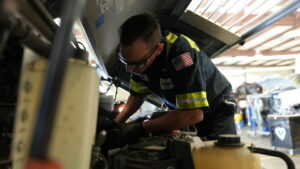Preparing your fleet for winter months takes resources, time, and money. But it’s the best way to prevent downtime due to dropping temperatures.
Resources: Focus on Preventative Maintenance
Although preparing your fleet for the winter months often requires additional resources, sitting on the side of the road with a downed vehicle in sub-zero temperatures can be life-threatening. For driver safety and fleet performance, preventing breakdowns in these conditions is essential.
Our approach to preparing your fleet for the winter months is to begin general winter maintenance as early as 90-100 days before winter begin to make sure all systems are in proper working order. This means completing all preventive maintenance checklists, driver complaints or warnings, and making sure snow tires and chains are available and stocked in inventory in some locations.
Time and Money: A Winter Maintenance Checklist
The best approach to preparing your fleet for the winter months is to prioritize a winter maintenance checklist to help your fleet save time and money.
Winter maintenance starts with the cranking system – the starter and the batteries. If an engine isn’t prepared for colder temperatures, starting it can be a challenge. As the temperature drops, fluids get thicker. This can mean more resistance and a decrease in the cranking speed of your engine.
When it comes to batteries, test their strength to ensure they are strong enough to make it through the entire winter. If they’re near the end of their battery life, investing money upfront to replace it could prevent a downed vehicle in extreme cold.
And for vehicles that won’t start, use glow plugs or block heaters. Use caution with glow plugs, and make sure they’re operating correctly. If running improperly, glow plugs can crank the batteries too much, running them down.
The cooling system should be next up on the winter maintenance checklist. Check and adjust the freeze protection in your antifreeze to ensure proper protection from extreme cold. The average ethylene glycol antifreeze mixed at 50/50 will start to freeze at -34°. The pH level should also be checked to ensure it’s not acidic. Too high acidity levels can cause corrosion and other problems.
One critical piece to preparing your fleet for the winter months is proper care for the windshield. The defroster is essential in preventing the windshield from icing or fogging up. Ensure that the heating system is in proper order early in the season because even warm climates experience frost in the winter. Always care for your fleet’s windshield by maintaining the wiper blades. Check for wear and replace any worn or damaged wiper blades immediately. After checking the wiper blades, technicians should install a winter blend washer fluid. General washer fluid – the traditional blue fluid – freezes at about
-20° and will start to slush before it reaches that temperature. There’s a colder weather blend for washer fluid that is orange or purple and is good to -40°. In areas of extreme cold, some fleets require a de-ice additive.
Winter Tires
Running on minimal tire tread in winter can be very dangerous. Although not all routes require winter tires, your fleet’s tires need as much traction as possible during winter months to ensure they are prepared for the wet conditions or sudden, unpredicted winter storms.
Pay special attention to uneven wear patterns. Uneven wear can indicate poor alignment or worn bearings, which can become even more dangerous in winter.
Another thing to keep in mind: tires tend to lose pressure in colder temperatures. Your drivers should be checking tire pressure every day during their pre-trip inspections. Even if pre-trip inspections are performed consistently, we recommend checking the tire pressure weekly.
The Air System
When considering all that must be done to prepare your fleet for the winter months, the air system might not be top-of-mind. However, the air system presents challenges in every season. In summer, condensation develops in the tank after compressing and releasing air. Drivers don’t need to drain their tanks daily, but it is essential to ‘burp’ the tanks and remove the accumulated moisture regularly. To ensure the air system is in top operating condition, the air dryer cartridge should be replaced at the start of every winter. This helps pull moisture out of the system, preventing it from getting into airlines, so drivers don’t head into winter months with excessive moisture.
Fuel Gelling is another task in your winter maintenance checklist to save your fleet money.
No.2 diesel starts gelling between 10-20°F. If your fleet uses blended fuels, we recommend anti-gel additives when temperatures reach 0°F. Putting this anti-gel additive into the tank can help keep the fuel from gelling. Another way to prevent fuel from gelling is using a water separator. This can help remove excess water to keep the vehicle running more efficiently. Even with the appropriate preventative maintenance, it’s essential to remember that if the fuel in the lines and injectors gel up, the only solution is to park the vehicle in a warm location and wait. The first place a fuel system will fail is in a clogged fuel filter. To prevent this failure during winter, fleets should replace the fuel filter whenever the oil is changed and switch to winter blend fuel or No.1 diesel.
Brake Shoes and Lights:
Snow and slush can cause brake shoes to freeze to drums. Drivers can do two things to prevent the drums from freezing when they stop the vehicle: park on level ground and keep the brakes released to cool them below freezing point.
Since there are fewer daylight hours, preparing your fleet for the winter months means properly operating lights. All lights should be inspected to ensure they are in good working order. Any lights that are broken or malfunctioning should be replaced as needed.
Conclusion:
Cold temperatures can make a bad situation worse. With a bit of planning ahead, and a systematic pre-winter preventative maintenance service, breakdowns are less likely, and trucks and drivers can stay safer on the road.
If you’d like to speak with us about how we can save your fleet resources, time, and money this winter, contact us here.
For news, posts, information and more, follow us on social media:




